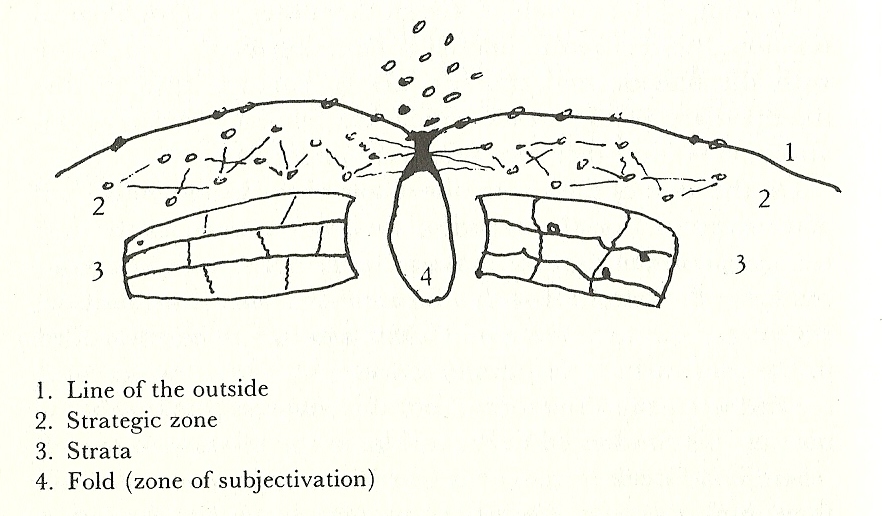| The Fold:
Does God Do Origami? Dave Harris From what I can see and make of Deleuze's commentary on Leibniz, the problem was to explain the 'necessary' reason behind everything, and then to see this common reason as somehow pointing to God. I'm no theologian, but I can see some difficulties with some conceptions of how this works. For example, does God divide himself into multiple parts and invest each one in the objects concerned, so there is a bit of God in me, and a bit of God in the tree in the garden, and in the woodlice in the soil beneath the tree? Since God is omnipotent, this is perfectly possible, but I can see the problems, not least of which arise from him having to unify all these parts somehow if he is going to act as some benevolent agent. This might be where Spinoza becomes important, incidentally. Earlier theologians saw the way to discover God as a matter of connecting the godly attributes distributed in everything. It ewasnot easy to distinguish the godly fromthemundane attributes. If I have understood it correctly, and simplifying horribly, Spinoza saw it the other way around that god realized himself in everything, as some kind of immanent essence, and this still left the problem of identifying what was imminent and what was merely contingent, which was the task of philosophy and the spiritual automaton. Leibniz offers another solution, possibly. God is a unified substance, but this unified substance is folded in highly complex ways to produce first the real and then the actual. It follows that all sorts of other folds are possible, those that offer possibilities coherent with everything else are called compossible, and those that would introduce a serious world-threatening contradiction are incompossible. God clearly prefers maximum coherence and complexity as the best of all possible worlds. Deleuze says that Leibniz took as his model, possibly unconsciously, baroque style. Elaborate baroque costumes were clearly composed by folded, pleated and gathered fabric to produce a 3D textured effects. The intricate decorative stucco on the outside walls of buildings were folded sheets of plaster producing cupids, flowers, gods and so on. Scvulpture featured lots of intricate folds (the example below is later). But -- if only Leibniz, and Deleuze, had ever tried to produce origami!  When Deleuze considers Foucault, he uses the notion of the fold again to explain subjectivity in Foucault. As we know, French philosophers have a problem with the usual English notion of the subject as a self contained sovereign consumer with his (sic) own personal values, perspectives and tastes. That notion omits all the social and linguistic forces that produce these apparently personal subjective insights and beliefs. At the same time, no one wants to see individuals merely as social puppets: they do possess something personal and subjective, even if this arises only from some sort of accidental biographical collision of social and linguistic processes. Apparently, Mrs. Deleuze was once happily hemming a garment, since even famous French philosophers need to have someone who will hem a garment, and Deleuze saw in the hem an interesting kind of fold that would explain subjectivity. All the personal and subjective stuff lies in the pocket produced by the hem, but it is still obviously connected to the outside. People occasionally strategically approach those bits of the outside whic are within reach, while at the same time various social processes and institutions struggle desperately to close the neck of the hem to produce a limited kind of subjectivity. Here is the diagram. Social strata of various kinds prevent any extension sideways.  I was sitting in Wagamama the other day, and they had thoughtfully provided their customers with a small square of paper and some instructions about how to fold this to produce an origami star. Eventually, I managed it. The instructions then went on to remind me that I could produce all sorts of other things with the same square. The legendary Mrs. Harris used to be a primary schoolteacher, and was once quite good at origami. Although I could not persuade her to actually refold this sheet of paper, I knew she was quite capable of refolding it, adding or subtracting nothing, to produce an origami frog, an origami bird, an origami star and so on. Same sheet, folded in different ways, to produce different actual objects.  We have recently had a plague of ladybirds chez Harris, and some of them remain indoors. They occasionally emerge from semi hibernation and wander about the office. I found one exploring between the pages of a printed article. What would happen if a ladybird decided to wander into an origami frog? It would trace along the particular surfaces. I suppose if it was a ladybird with the mathematical prowess of Leibniz, it would set to work to try to think of a way to describe the shape of the curves it was travelling along or able to observe, and come up with some ladybirdian calculus. Less talented ladybirds might come to different conclusions. If they happen to crawl inside a folded piece of paper, open only at the end that which they had entered, they would find themselves in a little confined world. They might well decide to make that little confined world a bit more interesting by populating it with memories, fantasies, imaginary beings, and our own little ladybird works of art. They might even be able to nibble small holes in it here and there, and drag in some more material from outside. Depending on where they were inside the folded frog or whatever it was, they would have different viewpoints on the world, different subjectivities, we might call them. It would still be the same world, however, there was providing them with their different viewpoints, or rather with the different places from which they would develop viewpoints. Here endeth the homely analogy. Now go off and try some origami for yourself: http://www.origami-instructions.com/ back to Deleuze page |
